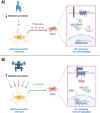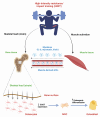Exercise for Postmenopausal Bone Health - Can We Raise the Bar?
- PMID: 40210790
- PMCID: PMC11985624
- DOI: 10.1007/s11914-025-00912-7
Exercise for Postmenopausal Bone Health - Can We Raise the Bar?
Abstract
Purpose of review: This review summarises the latest evidence on effects of exercise on falls prevention, bone mineral density (BMD) and fragility fracture risk in postmenopausal women, explores hypotheses underpinning exercise-mediated effects on BMD and sheds light on innovative concepts to better understand and harness the skeletal benefits of exercise.
Recent findings: Multimodal exercise programs incorporating challenging balance exercises can prevent falls. Emerging clinical trial evidence indicates supervised progressive high-intensity resistance and impact training (HiRIT) is efficacious in increasing lumbar spine BMD and is safe and well-tolerated in postmenopausal women with osteoporosis/osteopenia. There remains uncertainty regarding durability of this load-induced osteogenic response and safety in patients with recent fractures. Muscle-derived myokines and small circulating extracellular vesicles have emerged as potential sources of exercise-induced muscle-bone crosstalk but require validation in postmenopausal women. Exercise has the potential for multi-modal skeletal benefits with i) HiRIT to build bone, and ii) challenging balance exercises to prevent falls, and ultimately fractures. The therapeutic effect of such exercise in combination with osteoporosis pharmacotherapy should be considered in future trials.
Keywords: Exercise; Fragility fractures; Osteopenia; Osteoporosis; Postmenopausal; Resistance exercise; Weightbearing exercise.
© 2025. Crown.
Conflict of interest statement
Declarations. Humans and Animal Rights: This article does not contain any studies with human or animal subjects performed by any of the authors. Informed Consent: Not applicable. Competing Interests: The authors declare no competing interests.
Figures


References
-
- Mudiyanselage SB, Watts JJ, Gebremariam K, Abimanyi-Ochom J. Osteoporosis and fractures in Australia. A burden of disease analysis 2023–2033. Healthy Bones Australia. 2024. https://healthybonesaustralia.org.au/wp-content/uploads/2024/09/bod-2024.... Accessed Dec 2024.
-
- Reid IR, Billington EO. Drug therapy for osteoporosis in older adults. Lancet. 2022;399(10329):1080–92. 10.1016/S0140-6736(21)02646-5. - PubMed
-
- U.S. Preventive Services Task Force. Screening for osteoporosis: U.S. preventive services task force recommendation statement. Ann Intern Med. 2011;154(5):356–364. 10.7326/0003-4819-154-5-201103010-00307. - PubMed
Publication types
MeSH terms
LinkOut - more resources
Full Text Sources
Medical
Research Materials

